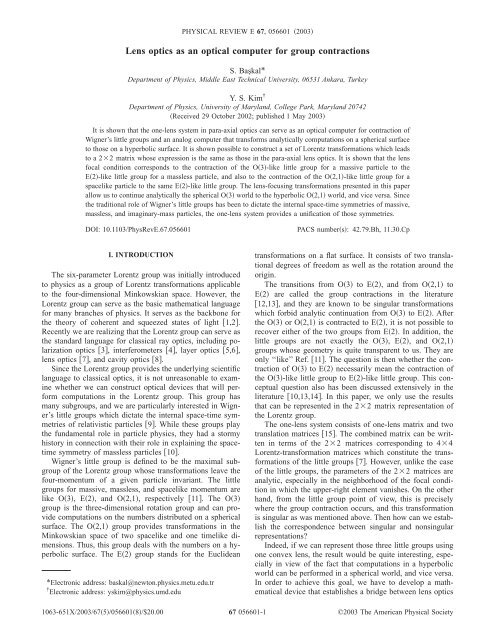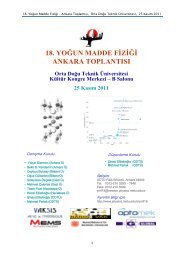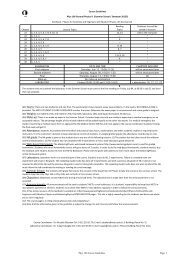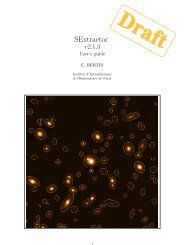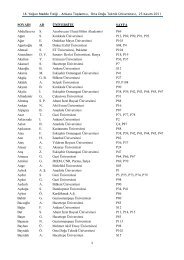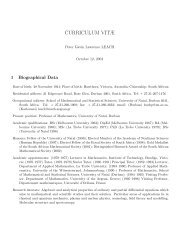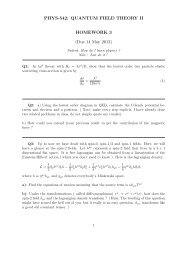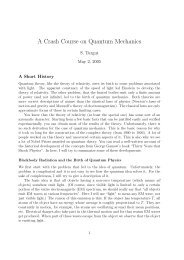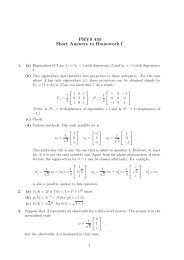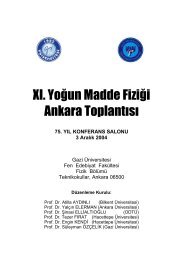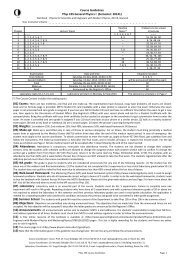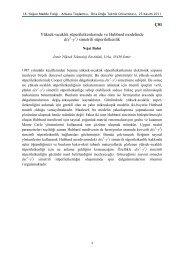Lens optics as an optical computer for group contractions - American ...
Lens optics as an optical computer for group contractions - American ...
Lens optics as an optical computer for group contractions - American ...
Create successful ePaper yourself
Turn your PDF publications into a flip-book with our unique Google optimized e-Paper software.
LENS OPTICS AS AN OPTICAL COMPUTER FOR . . .of Eq. 30. These matrices operate in two different spaces,namely, the rotation matrix on a circle <strong>an</strong>d the boost matrixon a hyperbola. Since we now have a procedure that makes<strong>an</strong> <strong>an</strong>alytic continuation from one to the other, we c<strong>an</strong> per<strong>for</strong>mcomputations in the hyperbolic world <strong>an</strong>d carry it to thecircular world.ACKNOWLEDGMENTWe would like to th<strong>an</strong>k Nikolaj Gromov <strong>for</strong> helpful comments<strong>an</strong>d <strong>for</strong> pointing out <strong>an</strong> error in Eq. 28 in the originalversion of the m<strong>an</strong>uscript.APPENDIX: GROUP THEORETICAL PROBLEMSThe correspondence between the Lorentz <strong>group</strong> O3,1<strong>an</strong>d SL2,c, the <strong>group</strong> of 22 unimodular matrices, is wellknown. Thus, we c<strong>an</strong> study the Lorentz <strong>group</strong> with 22matrices that are directly applicable to lens <strong>optics</strong>. Since it ismuch e<strong>as</strong>ier to underst<strong>an</strong>d explicit algebra of 22 matricesth<strong>an</strong> the theorems on Lie <strong>group</strong>s, we did not take the st<strong>an</strong>dardLie <strong>group</strong> approach in this paper. In so doing, some ofthe <strong>group</strong> theoretical issues were left unexplained in the maintext. The purpose of this appendix is to clarify those issues.First, the Lorentz <strong>group</strong> is a six-parameter <strong>group</strong>, withthree rotation <strong>an</strong>d boost generators. In this paper, the 22matrices have only two independent parameters. We startwith one lens matrix, two tr<strong>an</strong>slation matrices, <strong>an</strong>d thus withthree independent parameters. However, there is also the restrictionthat the determin<strong>an</strong>t of the matrices be 1. Thus, weare working with two free parameters. Then, how much in<strong>for</strong>mationdoes our work give to the full Lorentz <strong>group</strong> withthe six parameters?Second, the technique of <strong>group</strong> contraction is known <strong>as</strong> <strong>as</strong>ingular tr<strong>an</strong>s<strong>for</strong>mation. How does this process becomes <strong>an</strong>alyticin this paper?In order to <strong>an</strong>swer these questions, we would like to emph<strong>as</strong>izethat <strong>group</strong> theory papers do not have to start with theLie algebra. Wigner does not use <strong>an</strong>y of the generators in hiscl<strong>as</strong>sic paper on the inhomogeneous Lorentz <strong>group</strong> 9.Goldstein uses the Euler <strong>an</strong>gles to study three-dimensionalrotations 21. Let us look at the Euler <strong>an</strong>gles carefully.While the Lie algebra of the rotation <strong>group</strong> consists ofthree generators operating on the three orthogonal directions,the Euler <strong>an</strong>gles are defined only in terms of rotations aroundPHYSICAL REVIEW E 67, 056601 2003two directions. Repeated applications of rotations aroundthose two directions will lead to the most general <strong>for</strong>m of therotation matrix. In the l<strong>an</strong>guage of the Lie algebra, we startwith the three rotation generators J z ,J x , <strong>an</strong>d J y . On theother h<strong>an</strong>d, we c<strong>an</strong> start only with J z <strong>an</strong>d J x , because we c<strong>an</strong>get J y by taking the commutator of J z <strong>an</strong>d J x .The Lorentz <strong>group</strong> is generated by three rotation generators<strong>an</strong>d three boost generators. It is a six-parameter <strong>group</strong>.However, we do not need all these six generators. In order tocomplete the rotation sub<strong>group</strong>, we need only rotationsaround two orthogonal directions to construct all rotationmatrices. Let us introduce a boost along the z direction. Thenthe rotations c<strong>an</strong> ch<strong>an</strong>ge the direction of the boost to <strong>an</strong>arbitrary direction.Thus, we need repeated applications of two rotations <strong>an</strong>done boost to construct the most general <strong>for</strong>m of tr<strong>an</strong>s<strong>for</strong>mationmatrices of the Lorentz <strong>group</strong>. The tr<strong>an</strong>s<strong>for</strong>mation matricesc<strong>an</strong> have at most six independent parameters.In this paper, we start with one rotation <strong>an</strong>d one boost.But, there is <strong>an</strong>other rotational degree of freedom implicitlycontained in lens <strong>optics</strong>. This is the rotation around the <strong>optical</strong>axis 19. Thus, by making repeated applications of theone-lens system 22, we c<strong>an</strong> construct the most general <strong>for</strong>m<strong>for</strong> Lorentz-tr<strong>an</strong>s<strong>for</strong>mation matrices.Speaking of <strong>group</strong> <strong>contractions</strong>, a tr<strong>an</strong>sition of one <strong>group</strong>to <strong>an</strong>other <strong>group</strong> me<strong>an</strong>s tr<strong>an</strong>sition from one Lie algebra to adifferent algebra. There<strong>for</strong>e, the <strong>group</strong> contraction is necessarilya singular tr<strong>an</strong>s<strong>for</strong>mation in terms of the Lie algebraparameters. The inverse of the contraction is known <strong>as</strong> the<strong>group</strong> exp<strong>an</strong>sion in the literature. Indeed, Gilmore gives adetailed expl<strong>an</strong>ation of the tr<strong>an</strong>sitions among the O3, E2,<strong>an</strong>d O2,1 in his book 23. However, the <strong>group</strong> exp<strong>an</strong>sion isalso a singular tr<strong>an</strong>s<strong>for</strong>mation in terms of the Lie algebra.These singular tr<strong>an</strong>s<strong>for</strong>mations need specific additional conditions.For inst<strong>an</strong>ce, E2 c<strong>an</strong> be exp<strong>an</strong>ded to O3 orO2,1. In this c<strong>as</strong>e, we have to give specific additional instructions.In this paper, we used two different sets of parameters.One set consists of the Lie algebra parameters, which leadsto a singular tr<strong>an</strong>s<strong>for</strong>mation. The parameters of the other setare not Lie algebra parameters. The tr<strong>an</strong>s<strong>for</strong>mation is notnecessarily singular during the contraction <strong>an</strong>d exp<strong>an</strong>sionprocesses 19. We have given in this paper a set of parameterswhich c<strong>an</strong> be interpreted in terms of the Lorentz tr<strong>an</strong>s<strong>for</strong>mationswithin the framework of Wigner’s little <strong>group</strong>s.1 H.P. Yuen, Phys. Rev. A 13, 2226 1976.2 Y.S. Kim <strong>an</strong>d M.E. Noz, Ph<strong>as</strong>e Space Picture of Qu<strong>an</strong>tumMech<strong>an</strong>ics World Scientific, Singapore, 1991.3 D. H<strong>an</strong>, Y.S. Kim, <strong>an</strong>d M.E. Noz, Phys. Rev. E 56, 60651997. For <strong>an</strong> earlier paper on this subject, see C.V.M. v<strong>an</strong> derMee, J. Math. Phys. 34, 5072 1993.4 D. H<strong>an</strong>, Y.S. Kim, <strong>an</strong>d M.E. Noz, Phys. Rev. E 61, 59072000. For <strong>an</strong> earlier paper on this subject, see B. Yurke, S.L.McCall, <strong>an</strong>d J.R. Klauder, Phys. Rev. A 33, 4033 1986.5 J.J. Monzon <strong>an</strong>d L.L. S<strong>an</strong>chez-Soto, J. Mod. Opt., 48, 212001.6 E. Georgieva <strong>an</strong>d Y.S. Kim, Phys. Rev. E 64, 026602 2001.7 S. Başkal <strong>an</strong>d Y.S. Kim, Phys. Rev. E 63, 056606 2001, <strong>an</strong>dthe references contained in this paper.8 S. Başkal <strong>an</strong>d Y.S. Kim, Phys. Rev. E 66, 026604 2002.9 E.P. Wigner, Ann. Math. 40, 149 1939.10 Y.S. Kim <strong>an</strong>d E.P. Wigner, J. Math. Phys. 31, 551990.11 We use the word ‘‘like’’ instead of the <strong>group</strong> theoretical phr<strong>as</strong>e‘‘locally isomorphic to,’’ which me<strong>an</strong>s that the generators oftwo different <strong>group</strong>s satisfy the same set of commutation relations.The best known example is that the generators of theSU2 <strong>group</strong> satisfy the same set of commutation relations <strong>as</strong>056601-7
S. BAŞKAL AND Y. S. KIM PHYSICAL REVIEW E 67, 056601 2003the three-dimensional rotation <strong>group</strong>.12 E. Inonu <strong>an</strong>d E.P. Wigner, Proc. Natl. Acad. Sci. U.S.A. 39,510 1953.13 Y.S. Kim <strong>an</strong>d M.E. Noz, Theory <strong>an</strong>d Applications of thePoincaré Group Reidel, Dordrecht, 1986.14 H. Bacry <strong>an</strong>d N.P. Ch<strong>an</strong>g, Ann. Phys. N.Y. 47, 407 1968.15 A. Yariv, Qu<strong>an</strong>tum Electronics Wiley, New York, 1975.16 D. H<strong>an</strong> <strong>an</strong>d Y.S. Kim, Phys. Rev. A 37, 4494 1988.17 H.A. Haus, Waves <strong>an</strong>d Fields in Optoelectronics Prentice-Hall, Englewood Cliffs, New Jersey, 1984.18 J. Hawkes <strong>an</strong>d I. Latimer, L<strong>as</strong>ers: Theory <strong>an</strong>d PracticePrentice-Hall, New York, 1995.19 D. H<strong>an</strong>, Y.S. Kim, <strong>an</strong>d D. Son, J. Math. Phys. 27, 2228 1986.20 For <strong>an</strong> O2, 1-b<strong>as</strong>ed approach to light waves in nonvacuummedia, see Y.S. Kim <strong>an</strong>d L. H Yeh, J. Math. Phys. 33, 12371992.21 H. Goldstein, Cl<strong>as</strong>sical Mech<strong>an</strong>ics, 2nd ed. Addison-Wesley,Reading, 1980.22 E.C.G. Sudarsh<strong>an</strong>, R. Simon, <strong>an</strong>d N. Mukunda, Opt. Acta 32,855 1985.23 R. Gilmore, Lie Groups, Lie Algebr<strong>as</strong>, <strong>an</strong>d Some of Their ApplicationsKreiger, New York, 1974, <strong>an</strong>d the references containedin this book. See also N. Mukunda, J. Math. Phys. 8,1069 1967.056601-8


